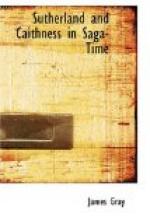Then followed Thorfinn’s conquests in Fife, and after relating the failure of a Scottish force, which had surrendered, to kill him by surprise, the Saga gives a lurid picture of his burnings of farms and slayings of all the fighting men, “while the women and old men dragged themselves off to the woods and wastes with weeping and wailing,” and it also tells of his journey north along Scotland to his ships.[13] “He fared then north to Caithness, and sate there that winter, but every summer thenceforth he had his levies out, and harried about the west lands, but sate most often still in the winters,” feasting his men at his own expense, especially at Yuletide, in true Viking style.
Allowing for exaggeration, it is not too much to say that Thorfinn and his cousin Macbeth must, after the death of their cousin Duncan in 1040, between them have held all that is now Scotland save the Lothians, until about 1057, when Macbeth was slain. To us it is interesting to note[14] that Duncan died, not in old age, (as Shakespeare, following Boece and the English chronicler Holinshed would have us believe) but a young man of thirty-nine years, either in, or after, Thorfinn’s battle, and that he fell a victim not of Groa, Macbeth’s wife’s cup of poison, but possibly of her husband’s dagger at Bothgowanan or Pitgavenny, a smithy about two miles from Elgin. We should also note that Thorfinn’s cruelty made it difficult for him ever to hope to obtain and keep the throne of Scotland, which thus fell to Macbeth.
Meantime Jarl Brusi had died about 1031, and though he left a son Ragnvald, this son was long abroad in Norway, where he was taught all the accomplishments suitable to his rank, and remained there at the time of his father’s death.[15] Ragnvald Brusi-son was “one of the handsomest of men, his hair long and yellow as silk, and he was stout and tall and an able splendid man of great mind and polite manners.” He had saved King Olaf’s brother Harald Sigurdson at the great battle of Stiklastad, after King Olaf, Ragnvald’s own foster-father, was killed, and had fought with great distinction in Russia. Shortly after his father’s death, Ragnvald returned, and, fortified by a grant from King Magnus of Norway, whom he had helped to gain the throne, claimed his father’s two trithings of the Orkney jarldom. To this Thorfinn, who after 1034 had his hands full with his war with King Duncan, and had always wars with the Hebrides and the Irish, agreed, and the two joined forces, and sailed on Viking raids to the Hebrides and England.[16]
About 1044 Thorfinn married Ingibjorg,[17] Finn Arnason’s daughter, and it is interesting to find that in the Saga Book of the Viking Club, Vol. IV, page 171, Mr. Collingwood suggests that the King of Catanesse, who fought for years to gain possession of Gratiana, the lost wife of William the Wanderer, was Thorfinn. If this story be founded on fact, as it probably is, this may account for his somewhat late marriage with Ingibjorg.




